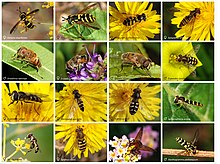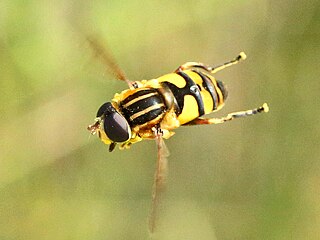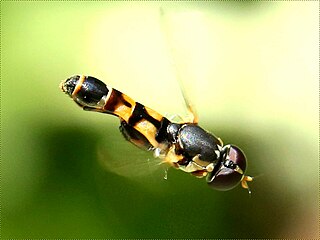| Syrphidae Temporal range:
| |
|---|---|

| |
| Sixteen different species of hoverflies | |
| Scientific classification | |
| Domain: | Eukaryota |
| Kingdom: | Animalia |
| Phylum: | Arthropoda |
| Class: | Insecta |
| Order: | Diptera |
| Section: | Aschiza |
| Superfamily: | Syrphoidea |
| Family: | Syrphidae Latreille, 1802 |
| Subfamilies | |
Hoverflies, also called flower flies or syrphids, make up the insect family Syrphidae. As their common name suggests, they are often seen hovering or nectaring at flowers; the adults of many species feed mainly on nectar and pollen, while the larvae (maggots) eat a wide range of foods. In some species, the larvae are saprotrophs specifically Detritivores [1] eating decaying plant and animal matter in the soil or in ponds and streams. In other species, the larvae are insectivores, preying on aphids, thrips, and other plant-sucking insects.
Insects such as aphids are considered crop pests, and therefore the aphid-eating larvae of some hoverflies are economically and ecologically important. The larvae are potential agents for use in biological control; while the adults are pollinators.
About 6,000 species in 200 genera have been described. Hoverflies are common throughout the world and can be found on all continents except Antarctica. Hoverflies are harmless to most mammals, though many species are mimics of stinging wasps and bees, a mimicry which may serve to ward off predators.
Hoverfly hovering behavior is unlike that of hummingbirds since they do not feed in midair. Hovering in general may be a means of finding a food source; male hovering is often a territorial display seeking females,[2] while female hovering serves to inspect ovipositing sites. [3][4][5]
- Adult hoverflies often hover over the plants they visit
- ^ Rotheray, G.E. (1993). "Colour Guide to Hoverfly Larvae (Diptera, Syrphidae) in Britain and Europe" (PDF). Dipterists Digest. 9: 155.
- ^ Collett, T.S.; Land, M.F. (September 1978). "How hoverflies compute interception courses". Journal of Comparative Physiology. 125 (3). Springer-Verlag: 191–204. doi:10.1007/BF00656597.
- ^ Almohamad, Raki; Verheggen, François J.; HaubrugeUniv, Éric (2009). "Searching and oviposition behavior of aphidophagous hoverflies (Diptera: Syrphidae): a review". Biotechnologie, Agronomie, Société et Environnement. 13 (3): 467–481.
- ^ Vera Strader. "Hover Flies, a Gardener's Friend" (PDF). University of California Agriculture and Natural Resources.
- ^ Peter Chen (December 6, 2023). "Allograpta exotica ovipositing - Allograpta exotica - Female". Bugguide. Iowa State University.



